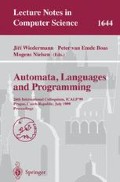Abstract
We discuss the problem of computing shortest an-isotropic paths on terrains. Anisotropic path costs take into account the length of the path traveled, possibly weighted, and the direction of travel along the faces of the terrain. Considering faces to be weighted has added realism to the study of (pure) Euclidean shortest paths. Parameters such as the varied nature of the terrain, friction, or slope of each face, can be captured via face weights. Anisotropic paths add further realism by taking into consideration the direction of travel on each face thereby e.g., eliminating paths that are too steep for vehicles to travel and preventing the vehicles from turning over. Prior to this work an O(n n) time algorithm had been presented for computing anisotropic paths. Here we present the first polynomial time approximation algorithm for computing shortest anisotropic paths. Our algorithm is simple to implement and allows for the computation of shortest anisotropic paths within a desired accuracy. Our result addresses the corresponding problem posed in [12].
Research supported in part by NSERC. Proofs will be provided in full version.
Access this chapter
Tax calculation will be finalised at checkout
Purchases are for personal use only
Preview
Unable to display preview. Download preview PDF.
References
L. Aleksandrov, M. Lanthier, A. Maheshwari and J.-R. Sack, “Anε-Approximation Algorithm for Weighted Shortest Path Queries on Polyhedral Surfaces”, 14th European Workshop on Computational Geometry, Barcelona, Spain, 1998.
L. Aleksandrov, M. Lanthier, A. Maheshwari and J.-R. Sack, “Anε-Approximation Algorithm for Weighted Shortest Paths on Polyhedral Surfaces”, SWAT’ 98, LNCS 1432, Stockholm, Sweden, 1998, pp. 11–22.
J. Choi, J. Sellen and C.K. Yap, “Approximate Euclidean Shortest Path in 3-Space”, Proc. 10th Annual Symp. on Computational Geometry, 1994, pp. 41–48.
G. Das and G. Narasimhan, “Short Cuts in Higher Dimensional Space”, Proceedings of the 7th Annual Canadian Conference on Computational Geometry, Québec City, Québec, 1995, pp. 103–108.
C. Kenyon and R. Kenyon, “How To Take Short Cuts”, Discrete and Computational Geometry, Vol. 8, No. 3, 1992, pp. 251–264.
M. Lanthier, A. Maheshwari and J.-R. Sack, “Approximating Weighted Shortest Paths on Polyhedral Surfaces”, Proceedings of the 13th Annual ACM Symposium on Computational Geometry, 1997, pp. 274–283.
C. Mata and J. Mitchell, “A New Algorithm for Computing Shortest Paths in Weighted Planar Subdivisions”, Proceedings of the 13th Annual ACM Symposium on Computational Geometry, 1997, pp. 264–273.
J.S.B. Mitchell and C.H. Papadimitriou, “The Weighted Region Problem: Finding Shortest Paths Through a Weighted Planar Subdivision”, Journal of the ACM, 38, January 1991, pp. 18–73.
J.S.B. Mitchell, “Geometric Shortest Paths and Network Optimization”, in J.-R. Sack and J. Urrutia Eds.,Handbook on Computational Geometry, Elsevier Science B.V., to appear 1999.
N.C. Rowe, and R.S. Ross, “Optimal Grid-Free Path Planning Across Arbitrarily Contoured Terrain with Anisotropic Friction and Gravity Effects”, IEEE Transactions on Robotics and Automation, Vol. 6, No. 5, October 1990, pp. 540–553.
M. Sharir and A. Schorr, “On Shortest Paths in Polyhedral Spaces”, SIAM Journal of Computing, 15, 1986, pp. 193–215.
R. Tamassia et al., “Strategic Directions in Computational Geometry”, ACM Computing Surveys, Vol. 28, No. 4, December 1996.
Paradigm Group Webpage, School of Computer Science, Carleton University, http://www.scs.carleton.ca/~gis.
Author information
Authors and Affiliations
Editor information
Editors and Affiliations
Rights and permissions
Copyright information
© 1999 Springer-Verlag Berlin Heidelberg
About this paper
Cite this paper
Lanthier, M., Maheshwari, A., Sack, JR. (1999). Shortest Anisotropic Paths on Terrains. In: Wiedermann, J., van Emde Boas, P., Nielsen, M. (eds) Automata, Languages and Programming. Lecture Notes in Computer Science, vol 1644. Springer, Berlin, Heidelberg. https://doi.org/10.1007/3-540-48523-6_49
Download citation
DOI: https://doi.org/10.1007/3-540-48523-6_49
Published:
Publisher Name: Springer, Berlin, Heidelberg
Print ISBN: 978-3-540-66224-2
Online ISBN: 978-3-540-48523-0
eBook Packages: Springer Book Archive

